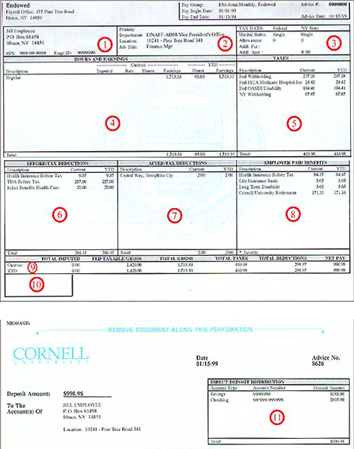What Does Oasdi Stand for on a Paystub
Below is an example of a Cornell paper pay stub. Each box is marked with a number, and each number has a corresponding explanation in the Pay Stub Details below.

Paper Stub Detail
- Box 1: Employee Information
- Box 2: Employer/Department Information
- Box 3: Employee Federal and State Withholding Tax Status
- Box 4: Hours and Earnings
- Box 5: Taxes
- Box 6: Before Tax Deductions
- Box 7: After Tax Deductions
- Box 8: Employer Paid Benefits
- Box 9: Summary Numbers
- Box 10: Leave Balances
- Box 11: Direct Deposit Distribution
- Commonly Used Deduction Acronyms
Box 1: Employee Information
Displays the employee's name, address, ID number and social security number. The employee ID number is a unique identifier for employees that is used by Cornell and the payroll processing system instead of the social security number. Use of the employee ID promotes personal security for all employees. If your social security number is not correct, contact the Payroll office immediately.
Note: When contacting the Payroll office or the Office of Human Resources, please have your employee ID number ready.
Top
Box 2: Employer / Department Information
Provides information regarding the department the employee is employed in, as well as the employee's job title. For multiple job employees (more than one job with Cornell), the information will be based on the lowest paying job record number, which is not always the primary job the employee works.
Top
Box 3: Employee Federal and State Tax Withholding Status
Provides the federal and state tax withholding status based on withholding certificate data on file with the Payroll office. The claimed status, in conjunction with current payroll withholding tables, determines federal and state income tax withholding as reported in Box 5. If certificates are not on file with the Payroll office, the default status of "single" and "zero (0)" are used. If a federal certificate (W-4 form) has been filed, but not a state certificate (e.g., IT-2104 for New York), the state withholding status will be equal to the federal status filed. Withholding certificates are available on the Withholding Certificates page. Most employees can also make changes using Workday.
Caution: Special withholding rules apply to foreign nationals. For more information, contact the Tax office.
Top
Box 4: Hours and Earnings
Displays compensation information, such as the rate for nonexempt employees. At this time, hours are displayed for all employees, although they are applicable only to nonexempt employees. The most common earning type used is "Regular," but below are other commonly used earning types:
- Regular Ancillary Pay
- Vacation Pay
- Sick Pay Hourly
- Personal Time
- Family Health Care
- Overtime Time & Half
- Shift Pay
- Retroactive Pay
- Comp Time Taken
- 1042 Study / Training (foreign national earnings)
- 1042 Teaching (foreign national earnings)
Top
Box 5: Taxes
Reflects the employer- and employee-paid federal, state, local, and social security taxes. Tax law requires Cornell to display both components of social security taxes: Medicare (FICA), and Old Age, Survivors, and Disability Insurance (OASDI).
Most common tax withholdings:
- Federal
- FICA Medicare Hospital Insurance - Medicare component of social security; withheld at the rate of 1.45% of base wage
- OASDI - social security component; withheld at the rate of 6.2% of the Box 3 wage base
- NY - state income tax
Top
Box 6: Before Tax Deductions
Displays the deductions withheld that are exempt from taxation, such as health insurance, select benefits, etc. However, retirement deductions and tax-deferred annuity (TDA) contributions listed in Box 6 are not exempt from social security taxes.
Top
Box 7: After Tax Deductions
Displays deductions withheld that are not exempt from taxation.
Top
Box 8: Employer Paid Benefits
Displays the employer's cost for the employee's benefits, such as health insurances, life insurance, etc.
Top
Box 9: Summary Numbers
Note: The formulas used below apply unless there is non-cash income.
- Total Imputed - Generally not applicable
- Fed Taxable Gross = Total Gross listed in Box 4 MINUS Before Tax Deductions, as listed in Box 6
- Total Taxes - See Box 5
- Total Deductions = Before Tax Deductions as listed in Box 6 PLUS After Tax Deductions as listed in Box 7
- Net Pay = Total Gross MINUS Total Taxes MINUS Total Deductions
Top
Box 10: Leave Balances
Leave balances are displayed only for nonexempt staff, because PeopleSoft, Cornell's payroll system, only manages hourly accrual balances.
Top
Box 11: Direct Deposit Distribution
Displays the distribution of direct deposit amounts.
Top
Commonly Used Deduction Acronyms
- CSRS - Civilian Service Retirement System
- CURP - Cornell University Retirement Plan
- FEGLI - Federal Employees Group Life Insurance
- FERS - Federal Employee Retirement System
- NYSERS - New York State Employee Retirement System
- OASDI - Old Age, Survivors, and Disability Insurance
- ORP - Optional Retirement Plan
- TDA - Tax Deferred Annuity
- TIAA - Teachers Insurance and Annuity Association
- TSP - Thrift Savings Plan
Top
What Does Oasdi Stand for on a Paystub
Source: https://www.dfa.cornell.edu/payroll/about/archives/epay/paystub
0 Response to "What Does Oasdi Stand for on a Paystub"
Post a Comment